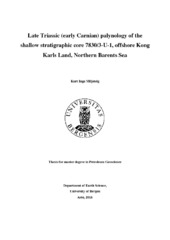Late Triassic (early Carnian) palynology of the shallow stratigraphic core 7830/3-U-1, offshore Kong Karls Land, Northern Barents Sea
Master thesis
Permanent lenke
https://hdl.handle.net/1956/12654Utgivelsesdato
2016-05-31Metadata
Vis full innførselSamlinger
- Department of Earth Science [1034]
Sammendrag
This study presents palynostratigraphic and palynofacies analyses from the shallow stratigraphic core 7830/3-U-1, drilled through the Snadd Formation (equivalent to De Geerdalen Formation) offshore Kong Karls Land in the northern Barents Sea, Norwegian Arctic. The Norwegian Petroleum Directorate have drilled several stratigraphic cores in the northern Barents Sea, which offer a unique insight into the Late Triassic stratigraphy and paleogeography of the region. This study constitutes a part of a broader palynostratigraphic investigation of the late Middle to Late Triassic of the Barents Sea, currently being undertaken at the University of Bergen, with the aim of improving the biostratigraphic resolution. Thirty-one samples from the approximately 200 m long core were analysed for palynological purpose. The core yielded great diversity of well-preserved palynomorphs. The palynological association is considered to constitute a single assemblage which is assigned an early Late Triassic (early Carnian) age, consistent with previously published age constraints including Re-Os datings from the area. Interpretation of sedimentological data, integrated with palynological and palynofacies data, indicates seven prograding parasequences, bounded by marine flooding surfaces, interpreted to range from offshore to delta front depositional environments. Palynofacies analysis suggest cycles of amorphous organic matter content and the presence of marine acritarchs (microplankton) strengthening the evidence of progradational parasequences deposited in a paralic environment. The high relative abundance of hinterland pollen types, e.g. bisaccate pollen, indicate transportation over large area. Spores are interpreted to reflect the local vegetation growing on the margins of the basin, such as abundant fern spores like Deltoidospora, Dictyophyllidites and Leschikisporis which were recorded and indicates a temperate and humid climate, consistent with previous interpretations of Late Triassic palaeoclimate on the northern Pangaean margin.
